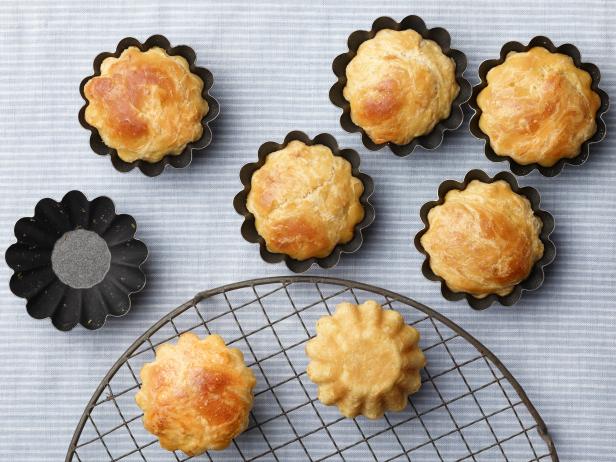| Level: | Intermediate |
| Total: | 12 hr 5 min |
| Prep: | 40 min |
| Inactive: | 11 hr 5 min |
| Cook: | 20 min |
| Yield: | 20 rolls |
Ingredients
- 1/2 cup warm water (110 to 120 degrees F)
- 1 package dried yeast
- 3 tablespoons sugar
- 6 extra-large eggs, at room temperature
- 4 1/2 cups unbleached flour
- 2 1/2 teaspoons kosher salt
- 12 tablespoons (1 1/2 sticks) unsalted butter, at room temperature
- 1 egg mixed with 1 tablespoon milk, for egg wash
Instructions
- Combine the water, yeast, and sugar in the bowl of an electric mixer fitted with the paddle attachment. (If the bowl is cold, start with warmer water so it’s at least 110 degrees when you add the yeast.) Mix with your hands and allow to stand for 5 minutes until the yeast and sugar dissolve. Add the eggs and beat on medium speed for 1 minute, until well mixed. With the mixer on low speed, add 2 cups of the flour and the salt and mix for 5 minutes. With the mixer still on low, add 2 1/4 more cups of flour and mix for 5 more minutes. Scrape the dough into a large buttered bowl and cover with plastic wrap. Refrigerate overnight.
- The next day, allow the dough to sit at room temperature for 1 hour. Meanwhile, grease 20 mini brioche tins. Set aside.
- Place the dough in the bowl of an electric mixer fitted with the dough hook, add the softened butter in chunks, and mix for 2 minutes, adding additional flour as needed to make a ball. Turn the dough onto a lightly floured board and divide the dough into 20 (1 3/4-ounce) balls and place them in the tins. Cover the tins with a damp towel and set aside to rise at room temperature until doubled in volume, about 2 hours.
- Preheat the oven to 350 degrees F. When the rolls have risen, brush the top of each with the egg wash and bake for 20 minutes, or until the tops spring back and it sounds slightly hollow when tapped. Turn the rolls out onto a wire rack to cool.
Nutrition Facts
| Serving Size | 1 of 20 servings |
| Calories | 201 |
| Total Fat | 9 g |
| Saturated Fat | 5 g |
| Carbohydrates | 24 g |
| Dietary Fiber | 1 g |
| Sugar | 2 g |
| Protein | 6 g |
| Cholesterol | 81 mg |
| Sodium | 148 mg |
Reviews
Like previous reviews I added at least an extra cup of flour to be able to handle dough. Farm eggs so may have been partly jumbos. For amt of butter and eggs, not impressed faith final product.
Need video to watch this recipe.
Great recipe and instructions. I added a lot of flour (like a cup) at the final kneeding however I do live in the USAs humidity capitol. I will definitely make this again.
Ina, can you talk the Food Network into showing this Episode again? or how about a VIDEO on the website, if not.
These are wonderful and so easy. You do have to start a day ahead of time. The dough can even sit in the refrigerator longer than overnight. You may also make them into two loaves if you like. I have had great success with this recipe every single time. I have another recipe for no-knead brioche from Cooks Illustrated that it much more complicated, a lot more work, and not nearly as good.
another recipe of ina that i have tried and it was a success… made it the first time and it came out perfect!!!.. :
Just made these wonderful brioche rolls–they turned out great! Just needed more time for dough to proof when out of the refrig, Another wonderful recipe–Thank You Ina!
First Ina recipe that flopped for me. I assume its something that I did wrong, but it barely rose and it was a big sticky mess. The only thing I thought I did differently was used bleached instead of unbleached flour– wasn’t sure that would be such a big deal. However, I noticed in reading this online recipe that the version in my Paris book calls for 2 sticks of butter not 1 1/2. Um, could that be the problem?? Did she really use 1 1/2 on the show?! Thoughts from any more experienced bakers??
Great recipe, incredible results. I just decided to add 2 additional tablespoon of sugar, that make them perfect for breakfast.
@meeksok let the dough rise covered for 1 to 3 hours, then gently fold over and press to expel excess gas. Then chill, shape, proof, bake. Not sure why this recipe calls for chilling first. I prefer Thomas Keller’s recipe. Jacques Pepin has a good one, too.
